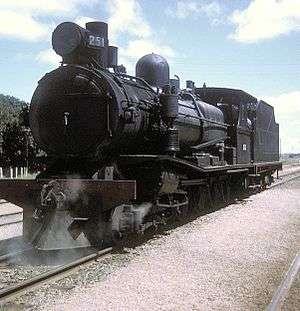South Australian Railways T class
|
T251 at Jamestown in October 1967 | |||||||||||||||||||||||||||||||
| |||||||||||||||||||||||||||||||
| |||||||||||||||||||||||||||||||
| |||||||||||||||||||||||||||||||
| |||||||||||||||||||||||||||||||
The South Australian Railways T class was a class of 4-8-0 steam locomotives operated by the South Australian Railways.
History
Between February 1903 and September 1917, the South Australian Railways (SAR) placed 78 T class locomotives into service. They were built by Islington Railway Workshops (4), James Martin & Co, Gawler (34) and Walkers Limited, Maryborough (40). They were initially conceived to work on the Broken Hill line between Terowie and Peterborough and Port Pirie and Cockburn, but later operated across the SAR network, including on the isolated Eyre Peninsula Railway. [1][2]
In 1922, six (219, 222, 223, 230, 235 & 237) were sold to the Tasmanian Government Railways, retaining their T class classification and road numbers. All were withdrawn between 1957 and 1961.[2][3][4]
In 1922/23, five were converted at Islington Railway Workshops from 3 ft 6 in (1,067 mm) narrow gauge to 5 ft 3 in (1,600 mm) broad gauge for use on the lightly laid Murraylands branch lines out of Tailem Bend depot. They were reclassified as the Tx class. In 1949, they returned to the narrow gauge. Between 1925 and 1939 all remaining 78 received superheated boilers.[2][4]
During World War II, many T class worked on the Central Australia Railway as far as Alice Springs. Five (46, 50, 212, 218 & 256) were temporarily transferred to the Commonwealth Railways as the NMA class and numbered 50 to 54. They returned to the SAR in 1942.[2]
Most remained in service until replaced by the 830 class in the 1960s.[2] The last examples were withdrawn when the Broken Hill line was converted to standard gauge in 1970.[5]
Preserved units
- T181 at the Sulphide Street Railway & Historical Museum, Broken Hill[6]
- T186 at the Pichi Richi Railway, Quorn operational until 2000[7][8]
- T199 at the Steamtown Peterborough Railway Preservation Society, Peterborough[9]
- T224 at the Millicent Museum[10]
- T251 at the Bellarine Railway, Queenscliff, returned to service April 2009[11]
- T253 at the National Railway Museum, Port Adelaide[5][12]
References
- ↑ Turner, Jim (1997). Australian Steam Locomotives 1896-1958. Kenthurst: Kangaroo Press. p. 41. ISBN 086417778X.
- 1 2 3 4 5 Oberg, Leon (2010). Locomotives of Australia 1850s-2010. Dural: Rosenberg Publishing. pp. 124–126. ISBN 9781921719011.
- ↑ "T Class 4-8-0 Locomotive" Australian Model Rail Magazine December 1982 page 117
- 1 2 "Steam Locomotives of the Tasmanian Government Railways and its Constituents" Australian Railway History issue 917 March 2014 page 11
- 1 2 T253 National Railway Museum
- ↑ T181 Australian Steam
- ↑ T186 Australian Steam
- ↑ South Australian Railways T class locomotives Pichi Richi Railway
- ↑ T199 Australian Steam
- ↑ T224 Australian Steam
- ↑ T251 Australian Steam
- ↑ T253 Australian Steam
